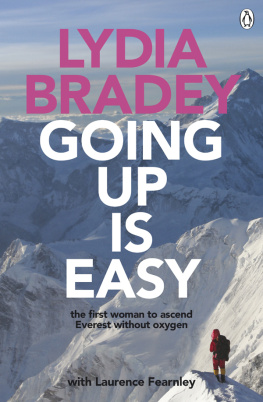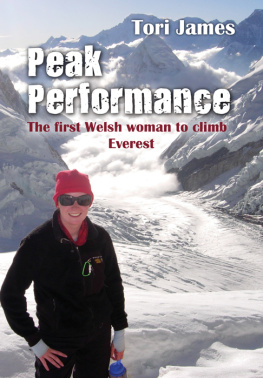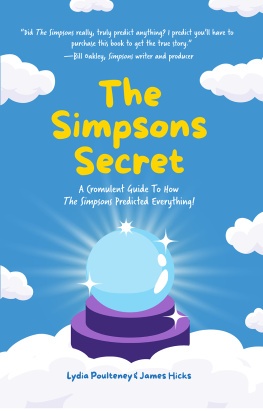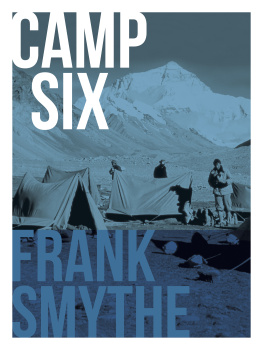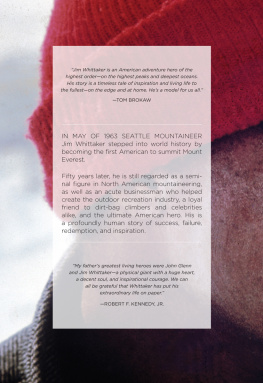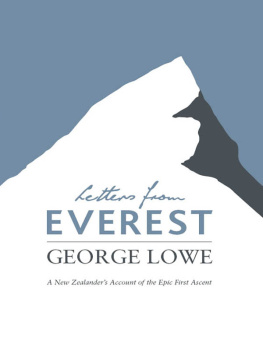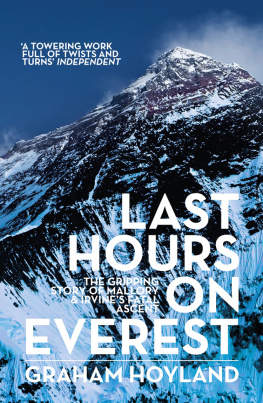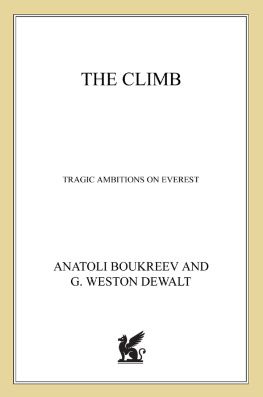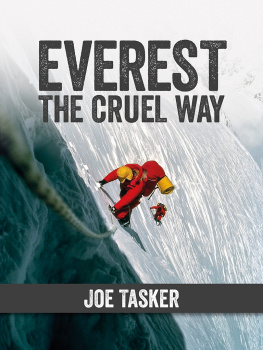PENGUIN
UK | Canada | Ireland | Australia
New Zealand | India | South Africa
Penguin Books is part of the Penguin Random House group of companies whose addresses can be found at global.penguinrandomhouse.com.
First published by Penguin Random House New Zealand, 2015
Text copyright Laurence Fearnley and Lydia Bradey, 2015 Photographs copyright Lydia Bradey, unless otherwise credited in captions, 2015
Cover, text design and maps by Carla Sy Penguin
Random House New Zealand
Painting inside cover: Everest Lhotse and Nupste and the Khumbu Icefall, Nepal by Dean Buchanan
Copyright page image: High on Zenith, Half Dome, Yosemite, 1982. Photo courtesy of Steve Monks
Cover images: Looking out from the Hillary Step, past the South Summit of Everest and beyond to Makalu, Nepal, 2012. Photo courtesy of Dean Staples; (back) Lydia on the Minarets, Aoraki/Mount Cook National Park, New Zealand, 2012. Photo courtesy of Michael Chapman-Smith; (back yap) Lydia on first ascent of the Wahine Shar, 5800m, Pakistan, 2007. Photo courtesy of Lorenzo Corona.
Title Page: The West Face of Lhotse (8516m) and Nuptse (7861m), from above Everest Base Camp, Nepal. Photo courtesy of Dean Staples; Dedication Page: Lydia abseiling off a rock tower in Falzarego area, Dolomites, Italy, 2013. Photo courtesy of Dean Staples.
The moral right of the author has been asserted.
All rights reserved.
ISBN: 978-1-743-48697-9
THE BEGINNING
Let the conversation begin...
Follow the Penguin - Twitter.com@penguinbooksnz
Keep up-to-date with all our stories - Youtube.com/PenguinGroupNZ
Pin Penguin Books NZ to your Pinterest
Like Penguin Books NZ on Facebook.com/PenguinBooksNZ
Listen to Penguin at SoundCloud.com/penguin-books
Find out more about the author and discover more stories like this at Penguin.co.nz
For my mother, Royce, my friend
and mentor, Jon Visser, and my
partner in life and mountaineering
adventures, Dean Staples.
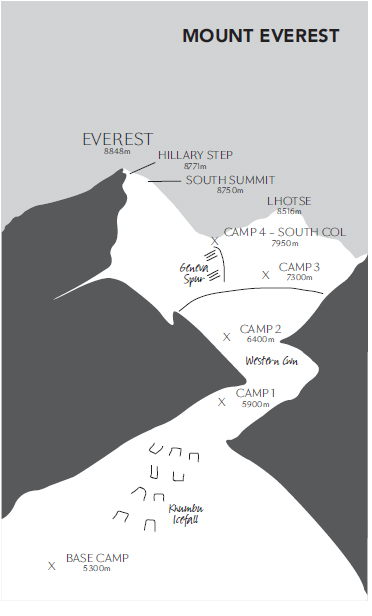
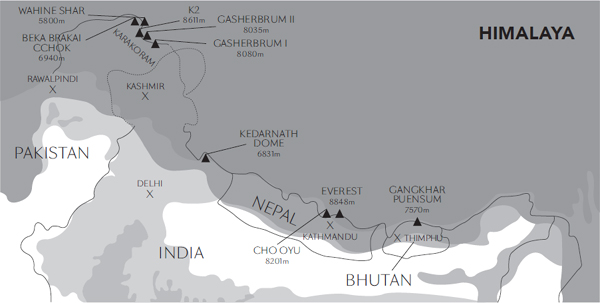
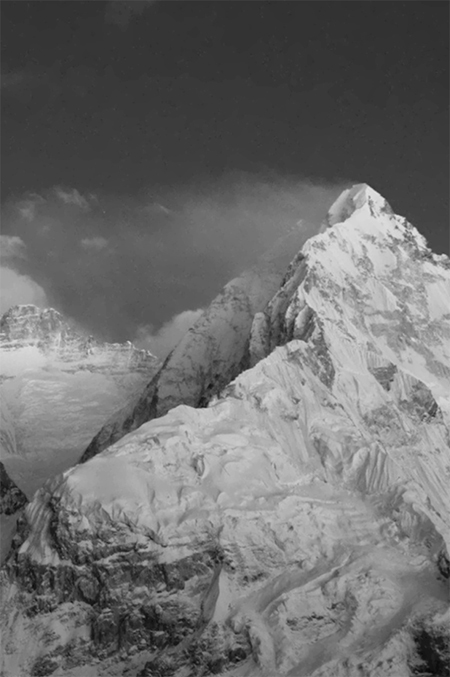
Authors Note
This is a personal memoir of events that have influenced my life. Some names have been changed to protect the privacy of individuals.
Conversation
Lydia Bradey and I shared a house back in 1989. She had recently returned from her oxygenless ascent of Mount Everest and was beginning an arts degree at the University of Canterbury. At the time she was also dealing with the fallout of having her climb disputed in the media. I had recently returned to Christchurch to take up a position as an assistant curator at the Robert McDougall Art Gallery. It was strange that we hadnt met before then, as Lydia had spent some time living at my parents home in the months leading up to her departure for the mountain. Whats more, everybody in the New Zealand climbing community knew Lydia either directly or, like me, by name. She had a significant reputation and profile long before her historic climb.
From the very start we got on well. We had different personalities in many respects she was by far the more social and outgoing but somehow we complemented each other. What I remember about that time was the sense of vitality that dominated our day-to-day life. As someone who prefers stillness to activity, and quietness to noise, I have strong memories of music Devo, Ofra Haza, This Mortal Coil and visitors. The house was full of people and we had a fantastic costume party, the only party I have ever been forced to host.
But, sometimes, the mood was sombre. Lydia was troubled about what was going on around her, the direction her life was taking, and her future. She was awaiting word from Nepal concerning her penalty for climbing Everest illegally, without a permit. On a more personal level, she was pretty lonely. She was still processing the grief surrounding the deaths of four of her closest climbing companions on Everest and she was separated from the man with whom she had formed a relationship while overseas. On top of that, her New Zealand boyfriend, Leo, was killed in a paragliding accident only a few months into their relationship.
We lived together for about 12 months but our friendship has continued to grow over the past 25 years. We see each other several times a year, visiting for a couple of days at a time. She is one of my closest friends.
A few years ago Lydia began to talk to me about her desire to write a book about her life and mountaineering experiences. Although she was keen to put her story onto the page, she was always too busy with mountaineering and guiding to find time to sit down and work. Id left the art world and was spending my days writing novels while being a housewife and mother. Im not sure how it came about but at some point Lydia realised that she might never find the time to write her autobiography and asked if Id be interested in helping her to create something. We talked about the project off and on and eventually I decided I liked the idea of helping but I wasnt interested in researching and writing a standard biography. Id recently completed a three-and-a-half-year stint at university and wasnt keen to spend another year or so in a library, combing through various archives or trawling through digital databases. Furthermore, I was unable to leave my family for travel, face-to-face interviews and the like. I was far more interested in a personal profile a text that presented Lydias version of events, told from a single point of view and in her words rather than as an amalgamation of numerous voices and diverse opinions.
Eventually it became clear that we both saw the book as a conversation. Our long friendship meant it seemed most natural to get together and talk. Lydia had boxes filled with letters, diaries and clippings and once I had read through her material a framework, and chapters, began to suggest themselves to us. Rather than presenting a continuous narrative, in which every minor detail is recorded, we have broken the book down into episodes: events that are significant in Lydias mountaineering career and personal life. We have also talked about various themes associated with mountaineering: risk-taking, companionship, death and sexual politics, for example.

